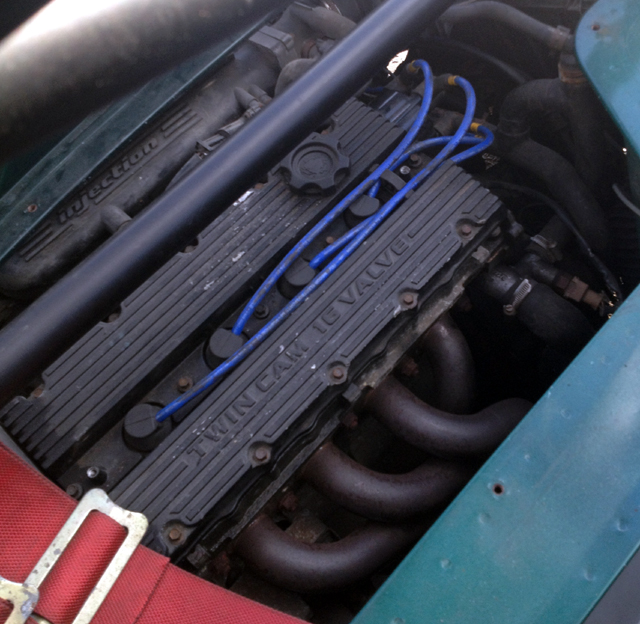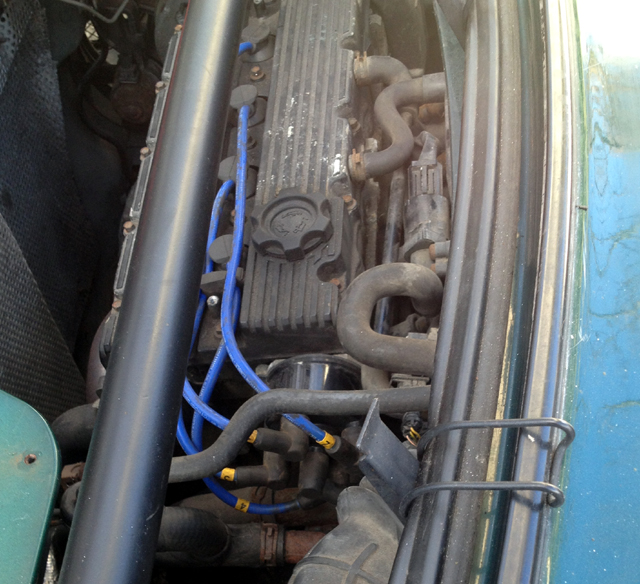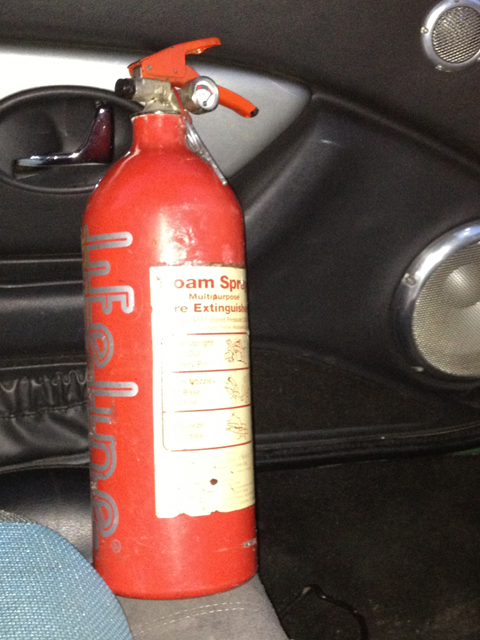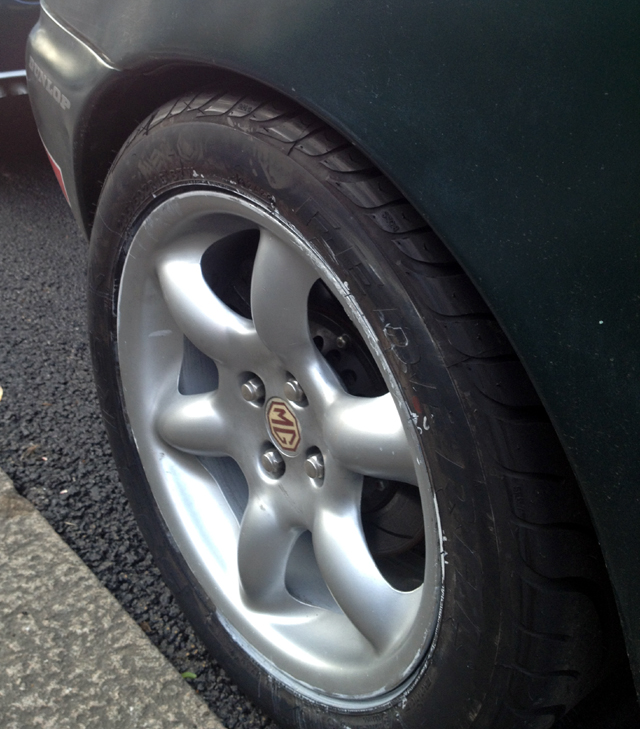
 |
Part 21: New beginnings
In the last instalment I brought you the end of beginning: Project Shed was registered for the road and road legal and, although we were not to compete in a Sprint or Hillclimb event, the old Shed did manage to complete a whole track day with only an alternator falling off and a brake warning light illuminating. Pretty uneventful then… ahem. But that was the point of getting the miles on the car – to see where the problems lay. Screwing the alternator back on and going over the braking system for the nth time for any more trouble was easy enough, but there was another problem I had noted on the way up to Donington and that both Tim and I discovered on track: a misfire.
It’s wet outside
Thank goodness it is now spring, because it has certainly been a winter to forget. Good weather for ducks, except the ducks were sunning themselves down south (because unlike humans, they’re sensible). During one of the wettest winters on record (I anticipate the hosepipe ban to come back into force any week now), our fleet of MGs were left out in the damp conditions, and sadly the ZTT decided that its battery was now no longer good enough for it – which meant that moving the family about in our other cars until such time a replacement battery could be secured (inevitably the battery had just past the end of its warranty period). Our other cars? Yes, our two MGFs! The kids enjoyed the two car convoys in two-seater sports cars. During the inclement weather there was another chance to see if any further problems cropped up. The windscreen wiper worked and the demister system sort of worked. But the main problem was that "Donington" misfire had mutated from a misfire to a difficulty in starting and then ultimately into a flat battery and a non-starting Project Shed. Argh!
If it looks like an apple, smells like an apple and tastes like an apple, it is an apple
Extreme damp conditions made me think that the basic problem was an ignition fault and the way that the initial misfire manifested under higher loads made me consider this an ignition fault. So it must be an ignition fault, yes? But where was the problem?
When the weather finally enabled me to work on the car without the aid of a snorkel, I removed the engine cover to investigate.
Those with amazing memories may recall that I had originally fitted new HT leads, but had to remove them because they were rubbish, and refitted the ones originally found on the engine as removed from the donor car (which were much better). Goodness knows how old they are. The distributor cap and rotor arm were effectively new and only around 880 miles old. The ignition coil was the original from the donor engine. Bearing in mind that I have since had to replace both the alternator and the starter motor on this engine, I did consider the coil to be a suspect, on the list to be investigated. So you can imagine my joy when I found on eBay a set of Magnecore leads and a coil pack for substantially less money than the leads alone would have cost new: two birds with one stone! I have the same Magnecore leads on my other MGF, which has done well over 90k miles over 15 years since I first fitted them with no problems whatsoever, I figured that buying second hand HT leads was not a difficult, soul-searching decision: these leads are, I believe, very good and reliable. Click-clickety-buy-now-click and they’re mine.

Inspection cover off, I replaced the old HT leads with lovely blue Magnecore items, changed the battery and tried again. Engine turned over well, but no start – not so much as a glimmer. Hmm. I took out each of the spark plugs to inspect in turn and they all looked healthy, with a good gap and no electrode damage. Nothing very obvious so far.
Is the coil okay and am I getting a good spark? The way to tell is to see whether you get a spark on turning the engine. So I earthed each plug in turn against the cam cover and cranked the engine. Yes, there is a spark. Perhaps not the strongest of sparks thinking back in retrospect (and giving the game away), but a fairly decent-looking spark nonetheless. To be sure I swapped over the coil for the eBay-sourced one and repeated the process – a similar spark on all four plugs. Okay, let’s go for another start.
Nothing. Nowt. Nada.
Urgh! This was getting frustrating. Spark plugs okay. HT leads okay. Effectively new distributor cap and rotor arm. Coil okay. Sparks being generated at all = ECU okay. What’s going on?
I took the distributor apart and wasn’t expecting to find much – it was nearly new after all, and the rotor arm looked fine, but the carbon electrode in its centre wasn’t anything like as long as I thought it should be – and I compared it to an older distributor cap that I’d previously removed from my other F – and lo, it had a longer centre carbon electrode. I swapped the caps and put everything back together. Did that make a difference? Guess what? No!
Arrrrrrghhhh!
|
|
I was still convinced that this was an ignition fault, but I checked the fuel system (just in case) – and yes the pump pumped, and on disconnecting the fuel line fresh fuel dripped out. No blockages – and since the spark plugs were by now wet with fuel, the injectors were evidently working. In any case I cleaned up the ECU earths, but you can guess that was to no avail. I even got my fault code reader out – no stored fault codes.
I was drawing more blanks than Terry Wogan on a 1970s game show. Scratching my head I phoned some friends (no new ideas other than the frankly slightly scary thought that the cam timing might have slipped) and went in search of an answer on the internet and various forums. Loads of really useful and thought-provoking suggestions – including the possibility of a crank sensor fault. Another other suggestion was a rotor arm. On MGBs, there have been plenty of dodgy ignition components floating about in recent years – including caps and rotor arms with too much carbon content (to make them black) and slightly different from original specifications. Red-coloured components were the way forward – but not for K-series engines. Hmm. Rotor arm – the only bit I hadn’t initially changed. I don’t now remember where this one came from but it was a bay-of-fleas purchase. Everything about this problem screamed ignition to me, so I went onto the Rimmer Bros web site and bought replacements for both the cap and rotor arm. I put my money where my intuition was telling me and I didn’t investigate any further until the replacement components promptly arrived.
With new bits in hand it didn’t take long to replace the distributor components. I turned around in the seat (I’d left the hardtop on and simply shuffled the inspection cover away to do the work), twisted the key and nearly jumped out of my skin when the sweet little twin-cam K-series burst instantly into life within a single revolution of the crank shaft! Flippin’ eck! That was easy!!!

All that hassle and wasted time: a misfire due to dodgy distributor components. Components that were only 880miles old for goodness sake! BEWARE – there are some seriously poor replacement parts out there, an observation that was seemingly confirmed by Tony (MGFSoldier) when he got a mate’s MGF running by replacing distributor components that were only 1100miles old…
Tinker time
Since that time I’ve put another 300 miles onto Project Shed, and all appears well. Nothing else has fallen off, no change in fluid levels and the car starts on the button. With a completive season of motorsport ahead what have I been doing? Thinking about making the car faster obviously. I’ve already introduced the idea of "Project50" where the aim is to get the weight of Project Shed down to a target of 950kg. The MGF Cup cars had a target weight of 970kg without hardtop, so presumably this is an achievable target? I’ll certainly have to lose the electric windows though! The other direction is to get a bit more power out of the engine. On Bernie Bowden’s rolling road, the Shed’s non-VVC 1.8-litre K-series recorded a respectable 134bhp (estimated flywheel), but I’d like to get a bit more – and the way forward is to fit hotter cams, a better breathing cylinder head and a brace of individual throttle bodies for each cylinder. I’ve made great progress on the latter, using a brace of motorbike throttle bodies from a 600cc Japanese sports bike for £50 – but more on that another time I think!
What else have I been up to? Well, the "to do list" prior to going racing is short, but isn’t getting any shorter by my ignoring it. The two critical items are (1) new tyres and (2) a new fire extinguisher.
(Don’t) Light My Flame
Why a new fire extinguisher? I have two already! But the problem is that they should be serviced every 5 years and mine, err, haven’t been. They’re old, and I don’t know whether they’ll work and one is reading over-pressure (see below: a gauge fault?) So I am trading these in and get one good one to replace the ballast the other two time-expired dud ones represent.

Time to re-tyre
The tyres that got Project Shed through its MoT last year are ancient and they only have marginal tread left. I’d already swapped one wheel for another (16" square spoke rather than 16" Abingdon-style for the other three) because that one tyre had cracked with age and the square-spoke had a correctly sized Goodyear F1 GSD2 (tyre-spotters will be interested to know that the other three were GSD3s – and the car still handled fine). It was well past the time for some new ones.
But what tyre to choose? The Shed will be used primarily as a track car, but driven to events – so one of the new breed of road-legal track tyres seemed a good bet. The darling tyre has been the Toyo R888 – but these are not as cheap as they used to be. The Yokohama A048 is hardly a budget friendly choice either – so how about something a little different? After some internet trawling, the Federal 585RSR looked like a good alternative to the R888 and is considerably cheaper. It is now used as the control tyre in a number of race series, and importantly, it seems to work well with mid-engine cars like the Porsche Boxster and Toyota MR2. But what size to choose?
It seems strange, but the 16" Abingdon-style wheel is actually lighter than the VVC 5-spoke 15" alloy (which is lighter than the 15" 6-spoke MPi alloy), so a tyre to suit a 16" rim it was to be. Unfortunately, the tyre sizes used on the MGF/TF are not common ones, and I have used 205/45R16s successfully in the past. But 205/50R16 are even more plentiful! So I started to search for these based on the assumption that speedometer accuracy was not a major consideration. Oponeo.com is a great place to find tyres at the moment, and were cheaper than other well-known on-line suppliers and happily, they had the 595RSR in stock in the desired 205/50R16 – so thanks to the power of the internet, clicky-click-clicky, and they were mine. All four tyres delivered within a week – good going!
205/50R16 are a fair bit taller than standard MGF tyres on this rim size, but I wasn’t too concerned because the Dunlop race tyres used on the MGF Cup cars are not too dissimilar in profile – 210/605 R16 racing slicks – so I knew they’d fit. But what I had not realised is that the wheel arches will need rolling to accommodate them! D’oh! Not the end of the world by any means, just not quite the "plug and play" solution that’d originally envisaged. This was made even more annoying by the later discovery that I could have bought the same tyre with a 205/45R16 profile that would have been just about ideal. Arrrrrgggghhhh!

Still, we all live by experience. First impressions of this tyre are very limited at the time of writing: I’ve only done a few miles with them fitted (going for a quick drive anywhere in London usually means sat in stationary traffic at any time other than 0400 in the morning), but those initial miles have not thrown up any untoward handling characteristics that have blighted other tyre choices. What they’re like at the limit I have no idea – only some time spent on track will shed light on that!
The one thing all this kerfuffle with the taller tyres and identifying the need to roll the wheel arches has thrown up is that the rear camber angles looks wrong on the offside rear wheel. Or at least, the camber isn’t as negative as it is on the nearside. That might not be a bad thing on a track car: almost all circuits have more right-hand corners than left-hand ones, so more negative camber on the nearside is better for grip (I bet this is how NASCAR racers are set up), but I haven’t really thought about the geometry since Keith at Tech-speed Motor Sport did the initial geometry set up at the old Mill. Something else to look at – perhaps after the end of the current season?
To cut a dash…
Given the self-inflicted own-goal with the tyre sizes, I thought I’d better find out whether the dashboard (or lack thereof) was going to cause problems with the MGCC Speed Championship. Road Going Modified class B regulations call for a dashboard to be fitted, or more specifically: "A fully functional standard dashboard must be retained, but may use replacement instruments and include additional instruments and switchgear. All interior fittings and trim panels may be removed. All carpets may be removed. At least two seats must be retained within the vehicle in their original positions. Seats may be replaced by unmodified commercially available competition seats. Steering wheel may be replaced with [a] non-standard component." The Shed’s interior is compliant with this part of the class regulations. But what exactly constitutes a "fully functional standard dashboard" on an MGF?
I’ve somewhat cheekily interpreted a "fully functional standard dashboard" as the instrument binnacle and cowl. But someone else might interpret that as meaning the whole moulded dashboard assembly… I really hope the official interpretation is not the latter because that dashboard assembly weighs a lot (comfortably over 5kg), and I’d be a sad MGCCSC competitor if all of a sudden my car weighs over a tonne when I’d worked so hard to get it down to 995kg! And would fully functional dashboard also include ventilation…? Yikes!!!!
Just in case I need to retrofit a standard dash moulding, I picked up a spare from Tony (aka MGFSoldier on the Register Forum) a month or two ago – and had the surprise of needing to pass through a military check point to get to his house! Still, everyone was friendly despite leaving the base with a suspicious structure strapped to the roof! The dash I’ve collected from Tony is missing the instrument binnacle (they all break don’t they?) and this really doesn’t matter. My instrument pack is mounted in a different place to standard, and there is no way it is going back to where it was: I won’t be able to see the clocks!!! The original binnacle moulding is superfluous. But a knackered old dash moulding will be ideal if I do need to install it: I’ll have no qualms at all about setting to with a saw, a drill and some wilful abandon to see how much weight I can take out of it!
It was time to "phone a friend" – or more accurately, drop the chief Scrutineer, Chris Mansley, an email. Hmm. I got the predictable response: he regarded the dashboard to be too bare. Well, it looks like Tony’s old, broken dashboard will now get a good seeing to!!! And since the dashboard is having to go in, I think it is time to take the EPAS ECU out! Despite the new tyres, steering loads are not bad, so the EPAS system can now be extracted. Which will hopefully mean that Project Shed will stay under the metric tonne – but it will mean that achieving the "Project50" has just got that little bit harder…
The competition is about to start…
The extra work represented by having to put a dashboard back in has put a bit of a delay on early Sprint/ Hill climb participation, but the objective now is to get entered into a competitive sprint by May – which looks to be Rushmoor – and then a flutter of events thereafter, including a track day at Snetterton, and perhaps even the Crystal Palace Sprint (non-championship event, but the MGCC are nonetheless and invited club)… Looks as though May could prove an exciting month!